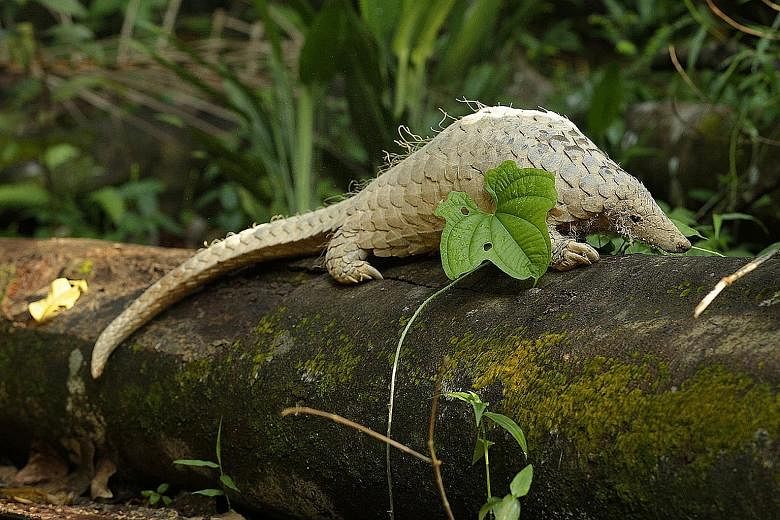It walks around clad in armour, yet the pangolin's defences cannot protect it from the threat of extinction. Ironically, its suit of scales is its greatest weakness.
Its keratin scales are made of the same protein found in human fingernails; however, some practitioners of traditional Chinese medicine believe they can reduce bleeding and help lactating women produce more milk.
Such misinformation has resulted in pangolins being poached from the wild; but tomorrow, the plight of the world's only scaly mammal will be highlighted during World Pangolin Day celebrations at the Night Safari.

There will be two talks held at the pangolin enclosure - at 7.45pm and 8.45pm - where visitors can learn more about the threats that pangolins face and what is being done to conserve them.
"Our call to action is for people to help us fight the illegal wildlife trade and not fuel demand for pangolin parts.
"Many species of trafficked animals, like the pangolin, often fall off the radar, compared to animals such as tigers or elephants," said Dr Sonja Luz, director of conservation and research at Wildlife Reserves Singapore (WRS), which manages the Night Safari.
Of the eight species of pangolin found worldwide, the Sunda pangolin is the only one that can be found here, mainly in the Bukit Timah and Central Catchment Nature Reserves.
As insect-eaters, pangolins play an important role in the forest ecosystem. "Certain species of termites, if not controlled, have the ability to wipe out entire forests. But pangolins help keep their populations in check," said Dr Luz.
Besides being pestbusters, they aerate the soil when they dig to find food or create burrows. This introduces oxygen and nutrients to the soil and benefits the roots of plants and animals that live underground.
Despite their ecological importance, pangolins are known more for their commercial value - which is why they are so heavily poached. Their scales can fetch up to US$3,000 (S$4,200) a kg, with each scale weighing between one and four grams.
Pangolins are also hunted for their meat, considered a delicacy in many parts of China. As their weight determines their value, the animals are often force-fed after capture.
Singapore is among the safest places for the Sunda pangolins as poaching is not as widespread, but they are still critically endangered due to the loss of forest habitats.
The National Parks Board (NParks) estimates that there are more than 100 wild pangolins here.
Its director of conservation Wong Tuan Wah said: "In Singapore, habitat loss as a result of urbanisation remains a threat for pangolins as they are slow-moving and are injured or killed by vehicles when they stray too far off from forested areas onto roads."
In 2014, a pangolin working group comprising local researchers was formed to gather feedback on outreach and research activities to maximise conservation efforts.
Four research projects funded by the WRS Conservation Fund have been undertaken since the start of the year.
Examples include faecal analyses to study the diet and microbial community in the gut of pangolins, as well as projects to study the genetic make-up of the pangolins in Singapore, and their movement and behaviour after they are rescued and released back into the wild.
Another project will look at using dogs in studies.
"The use of sniffer dogs could help researchers locate faecal samples, for example, or help researchers identify where they tend to burrow," Dr Luz said.
NParks' Mr Wong said the board's conservation efforts centre on safeguarding and enhancing the habitats in nature reserves to help native animals thrive.
This includes partnering agencies such as WRS and the National University of Singapore on a pan- golin translocation programme, in which pangolins found to have strayed from forested areas are rescued, rehabilitated and released back into the wild at appropriate locations.
Some facts about pangolins
•Scales are commonly found on reptiles and fish, but pangolins are the only mammals in the world that have them. They use their scales as a defence mechanism. When attacked by predators, such as leopards, they curl up into a ball so that the hard keratin envelops all of their soft parts. Unfortunately, this does not protect them from humans, who can simply pick them up and cart them away.
•There are eight species of pangolin around the world, four of which can be found in Asia: the Sunda, Palawan, Chinese and Indian pangolin. Some species live in trees, although others prefer burrowing in the ground.
•All eight species are protected under national and international laws. Two are listed as critically endangered on the International Union for Conservation of Nature Red List of Threatened Species - the Chinese and the Sunda pangolin, the latter of which can be found in Singapore.
•Pangolins usually have only one offspring, which travels with its mother until it is about six months old.
•In captivity, pangolins have a lifespan of about 20 years. Pangolins are notoriously difficult to keep in captivity as they are very easily stressed and often refuse to eat. They have very special dietary requirements that are not easily copied in captivity.
•The Night Safari has seven Sunda pangolins, comprising three males and four females. Two of them were bred there - the first time Sunda pangolins were bred in captivity - while the others were confiscations or donations from within Singapore . The Night Safari has created a special diet comprising ants' eggs, finely minced beef, mealworms, essential vitamins and calcium powder for the pangolins, which they are now thriving on.
SOURCE: WILDLIFE RESERVES SINGAPORE, WORLD WILDLIFE FUND, MARCUS CHUA



